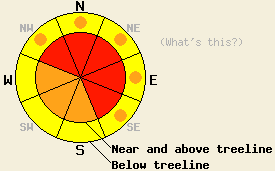
This Avalanche Advisory was published on March 4, 2009:
Forecast Discussion:
A strong storm system is winding down this morning. Snow showers are expected for the remainder of the day. New snowfall amounts overnight are running 20 to 26 inches above 6,500'. This brings storm totals thus far up to 45 to 55 inches over the past 60 hours. Air temperatures fell continuously overnight and are in the teens this morning at most locations above 6,500'. Air temperatures in the teens and 20s are forecast for today. Ridgetop winds have decreased from strong to moderate in speed overnight and shifted from southwest to west.
Yesterday, on Tamarack Peak (Mount Rose area) significant amounts of blowing and drifting snow, quickly erased all evidence of skier tracks. Stability tests made on N and NE aspects at 8,800', 9,200', and 9,700' revealed easy shears within the upper portion of the new snow. Further stability tests indicated that fracture propagation was not likely on these failure layers within the new snow, above the elevation of the most recent rain crust formation. On Schallenberger Ridge (Donner Summit area) significant blowing and drifting snow was noted both above and below treeline. Some very short shooting cracks were also noted on an infrequent basis. Stability tests performed on a NW aspect at 7,250' revealed easy shears with fracture propagation also unlikely in this area. Very poor visibility has kept the distribution of natural avalanche activity in the backcountry unknown. Overnight, around 2 feet of new snow has fallen in most areas. Continually decreasing air temperatures will have helped to place lower density new snow on top of higher density new snow. Decreasing winds will have allowed for more wind loading of new snow in the upper portion of avalanche start zones. Very smooth and easy shears at the base of the storm snow were reported this morning from the Alpine Meadows snow study plot at 6,800.
The Kirkwood Professional Ski Patrol reported that yesterday, deep avalanches with very significant fracture propagation at the base of the storm snow on the March 1-2 rain crust occurred in response to explosive control work. While this has not been observed in a backcountry, non explosive manipulated snowpack, potential for this type of snowpack failure does exist.
Today, a good window for natural and human triggered avalanche activity will continue through this morning. As snowfall tapers to showers, areas of blowing snow will allow natural avalanches to remain possible. Human triggered avalanches will be possible throughout the day today, especially in steep wind loaded areas. Avalanche activity that occurs today is expected to involve snowpack failure either within the new snow or possibly at the March 1-2 rain crust at the bottom of the storm snow. Increased faceting is expected to have occurred on top of the recent rain crust creating a potential weak layer. Very large and destructive avalanches are expected to occur today. Consequences of becoming caught in a avalanche today may be severe.
The bottom line:
Near and above treeline, avalanche danger is HIGH on NW-N-NE-E-SE aspects, 35 degrees and steeper. Below treeline, avalanche danger is MODERATE with pockets of CONSIDERABLE danger in open, wind affected areas, 37 degrees and steeper.
Weather Observations from along the Sierra Crest between 8200 ft and 8800 ft:
| 0600 temperature: | 11 deg. F. |
| Max. temperature in the last 24 hours: | 23 deg. F. |
| Average wind direction during the last 24 hours: | Southwest shifting to west. |
| Average wind speed during the last 24 hours: | 60 mph |
| Maximum wind gust in the last 24 hours: | 112 mph |
| New snowfall in the last 24 hours: | 30 to 35 inches |
| Total snow depth: | 167 inches |
Two-Day Mountain Weather Forecast - Produced in partnership with the Reno NWS
For 7000-8000 ft: |
|||
| Wednesday: | Wednesday Night: | Thursday: | |
| Weather: | Cloudy skies with snow in the morning. Scattered snow showers in the afternoon. | Mostly cloudy with scattered snow showers in the evening. Isolated snow showers after midnight. | Mostly cloudy skies with a chance of snow showers. |
| Temperatures: | 20 to 26 deg. F. | 2 to 9 deg. F. | 25 to 32 deg. F. |
| Wind direction: | SW to W | W | SW |
| Wind speed: | 10 to 15 mph with gusts to 25 mph. | 10 to 15 mph with gusts to 25 mph in the evening. | Around 10 mph. |
| Expected snowfall: | 2 to 4 in. | Trace to 1 in. | 0 to trace in. |
For 8000-9000 ft: |
|||
| Wednesday: | Wednesday Night: | Thursday: | |
| Weather: | Cloudy skies with snow in the morning. Scattered snow showers in the afternoon. | Mostly cloudy with scattered snow showers in the evening. Isolated snow showers after midnight. | Mostly cloudy skies with a chance of snow showers. |
| Temperatures: | 11 to 18 deg. F. | -1 to 6 deg. F. | 23 to 29 deg. F. |
| Wind direction: | SW to W | W shifting to SW | SW |
| Wind speed: | 15 to 25 mph with gusts to 45 mph. | 15 to 25 mph with gusts to 40 mph, decreasing to 10 to 15 mph after midnight. | Around 10 mph. |
| Expected snowfall: | 2 to 4 in. | Trace to 1 in. | 0 to trace in. |


















